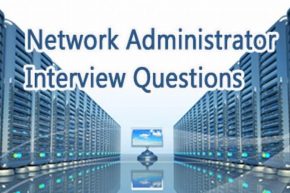Network Administrator Interview Questions and Answers

Network administrator is responsible for the smooth, efficient and secure operation of computer networks. They configure and administer existing networks. Their main tasks include customization of the network as per organization’s needs, adding software and hardware, troubleshooting, logging errors, helping users with network issues etc. Following are some frequently asked network administrator interview questions and answers. Before appearing for the interview for Network administrator, make sure that you have enough knowledge about the technical aspects. Mostly the questions asked in such interviews are all technical based.
1 Q: What are the critical skills a network administrator should have?
A: Network administrators need a unique blend of highly specialized technical skills along with excellent people skills. They should also possess project management skills. There is a demand for highly skilled, highly capable and highly qualified network administrators.
2 Q: How comfortable are you working in a computerized environment?
A: The work of a network administrator involves working in a computerized environment and sitting for long hours in front of the computer. The interviewer wants to find out whether you are comfortable with such an environment. Your answer should be in the positive and assure the interviewer that you are used to such environment in previous jobs.
3 Q:. What experience do you have with security support and maintenance?
A: Network administrators are responsible for implementing and maintaining regular security support. Security involves firewall installation, cryptography, back up and recovery etc. Mention in detail the experience you have in security support and maintenance.
4 Q: How do you perform system maintenance?
A: The overall function of a network administrator is to keep the system up and running. Applying latest software updates, adding and replacing hardware and adding new software are some tasks which a network administrator has to undertake for system maintenance. You can give examples from your previous jobs where you have been taking care of system maintenance.
5 Q: Are you familiar with network architecture?
A: As a network administrator, your tasks will generally fall into areas as designing and planning the network, setting up the network, maintaining and expanding the network. So a network administrator has to be familiar with network architecture. However, not all administrators specialize in the structure of computer systems.
6 Q: Do you have experience working in a team or training other employees?
A: Administrators may work alone or in teams, depending on the size and needs of the organization or department. Mention if you have experience working in a team or training employees. The interviewers view this as an added advantage for the position of network administrators.
7 Q:. What is the difference between TCP and UDP?
A: TCP stands for Transmission Control Protocol. UDP is a User Datagram Protocol. TCP can establish a connection whereas UDP cannot. TCP provides a stream of unlimited length whereas UDP sends small packets. UDP is faster for sending small amounts of data since no connection setup is required, the data can be sent in less time then it takes for TCP to establish a connection.
8 Q:. What is a VLAN?
A: A virtual local area network is a logical group of workstations, servers, and network devices that appear to be on the same LAN despite their geographical distribution. A VLAN allows a network of computers and users to communicate in a simulated environment as if they exist in a single LAN and are sharing a single broadcast and multicast domain. VLANs are implemented to achieve scalability, security and ease of network management and can quickly adapt to change in network requirements and relocation of workstations and server nodes.
9 Q:. When would you use a crossover cable?
A: If you need to connect two computers but you don’t have access to a network and can’t set up an ad hoc network, you can use an Ethernet crossover cable to create a direct cable connection. A crossover cable is constructed by reversing the order of the wires inside so that it can connect two computers directly.
10 Q: What is virtual path?
A: The location of a file or directory on a particular server, as seen by a remote client accessing it via World Wide Web. A virtual path provides access to files outside the default directory and subdirectories. An access control list can be associated with a virtual path.
11 Q: Describe DHCP.
A: Dynamic Host Configuration Protocol is a client/server protocol that automatically provides an Internet Protocol host with its IP address and other related configuration information such as the subnet mask and default gateway. DHCP allows hosts to obtain necessary TCP/IP configuration information from a DHCP server. The DHCP server service provides benefits such as reliable IP address configuration and reduced network administration.
12 Q: Define stuck in active.
A: If a successor route (best route) fails, then the router sends a query message to its neighbor demanding a feasible successor (back up route) and a query received by the router may be forwarded to other neighbors that could lead to a loop, as well. The wait for the response of query message is called stuck in active.
13 Q: What is route reflector and why is it required?
A: Route reflector is a solution for BGP split horizon. The rule says prefix learned from an IBGP neighbor will not be advertised to another IBGP. To overcome this situation, options include make your network a full mesh, route confederation and confederation. Route reflector is something like a central point acting as a route reflector server. Rather than peering with every IBGP router in a full mesh, it makes IBGP neighbors as route reflector clients to overcome the split horizon issue.
